Wisconsin has 11 species of turtles. Of these, the Ornate Box turtle is considered endangered and the Blandings and Wood turtles are considered threatened within the state.
Like all reptiles, turtles are cold-blooded or ectothermic which means they rely on the environment for heat. Turtles in Wisconsin have made some neet adaptations to living in a place that gets quite cold in winter.
This article has some general information on turtles and then takes a deep dive into each species in the state that will help you identify them. And of course, we have conservation information and how you can help turtles!
Can Turtles Remove Their Shell?
Cartoons often depict the turtle shimmying out of its shell. In reality, the shell is part of the body. The backbone is fused to the carapace or top shell.
The top of the shell is the carapace and the bottom is the plastron.
What is an anapsid skull?
In addition to their unique shell turtles have an anapsid skull. This is a very primitive skull shape and turtles are the only living animals to possess one.
The anapsid skull has no temporal openings, just openings for nostrils and eyes. Other skulls have openings near the temples.
What Animals Eat Wisconsin Turtles?
Young turtles are prone to predation. Hatchlings are born with a soft shell which makes them easier to consume.
One exception is the baby snapping turtle who is born with a rough carapace that makes predators less likely to chomp them. They hide at the muddy bottom of ponds. As their shells harden they become more active and swim around.
Predators will eat young turtles and also raid turtle nests. They include badgers, coyotes, raccoons, ravens, and sandhill cranes.
Reproduction
Turtles in Wisconsin will breed during their active season. However, the most common months are April and August.
Some turtles will lay two clutches of eggs per season. One in spring and one in late winter. Depending on the temperature the later eggs may not hatch until the following spring.
Once a female lays her eggs she leaves the nest. When the baby turtles are born they are on their own to find food and sunshine.
One of the reasons we have declining turtle populations is that when habitat gets fragmented it makes it difficult for turtles to find mates. Another is the predation of nests.
Blanding’s Turtle
Emydoidea blandingii
A medium-sized turtle with a high domed shell that is dark in color with yellow markings. They have a yellow chin which can help identify them.
They sometimes get mistaken for the ornate box turtle because of their domed shell. The Blanding’s turtle lives in much of the state with the exception of the far northern counties.
The Blanding’s turtle is semi-aquatic, living in and around a variety of water habitats. They will even inhabit diurnal water sources such as drainage dishes and wet meadows. They typically move to deeper water in winter to bromate.
They are an omnivore and eat crayfish, snails, tadpoles, and vegetation.
Blanding’s are considered threatened in the state. While they don’t have federal protection, they are considered endangered or threatened in all states where they are found. Canada lists them as federally protected.
They will often travel 1.5 miles to find a nesting area where the females lay an average of eight eggs. They prefer to nest in sandy soil not far from the water and display nest site fidelity which means they return to the same nesting location each spring.
The Blanding’s Turtle and Aging
The Blandings turtle is of great interest to scientists. Not only do they live a long time, but they also show few signs of aging. A Blanding’s turtle can reproduce well into their 90s.
However, they are slow to mature and don’t reach reproductive age until they are in their late teens. This slow reproductive rate is one reason their population is declining.
Common Snapping Turtle
Chelydra serpentina
Found throughout the entire state, the Snapper is the largest species found here. They live in ponds, lakes, and slower-moving rivers. They are the largest turtle found in the state.
Snapping turtles have a dark greenish or grey shell that has a sawtooth edge near the tail. They have a large head and prominent beak. Be careful - these turtles can and will bite!
Adult snapping turtles have few predators, except humans, due to their large size and aggressive behavior. However, eggs and hatchlings are often preyed upon.
Snapping turtles are predators as well as scavengers. They eat a variety of fish, frogs, and carrion.
We often observe snapping turtles when they are out of the water and crossing a road or hiking trail in search of a new feeding area or nesting spot. They are one of the few turtles that travel a considerable distance - up to three miles. You may also spot them basking by floating on the surface of the water.
Although snapping turtles are a species of least concern their populations have been decreasing due in part to their popularity in the pet trade.
The Alligator Snapping Turtle is not found in Wisconsin. You can read more about this endangered turtle in our article XX
Map Turtles
We have three species of map turtles in Wisconsin. They prefer to live in rivers. Sometimes referred to as the sawback turtle because of the ridge along the carapace and serration along the posterior rim.
They live along the Mississippi River delta from Wisconsin to the gulf.
Common Map Turtle
Has a smooth olive-brown carapace with pale yellow markings. The back end of the shell has moderate serration.
The female of this species is much larger than the male. They have strong jaws which allow them to eat crayfish and mollusks.
False Map Turtle
Graptemys pseudogeographica kohni
The false map turtle is of special concern.
A large river species they look similar to the Ouachita map turtle. They prefer large rivers with sandy or gravel bottoms.
They are typically active from April through October and breed in the spring or fall. False Map turtles may double-clutch during their active period and lay eggs twice.
Ouachita Map Turtle
Graptemys ouachitensis
Locally common the Ouachita (wa-chi-tau) has a dark olive green carapace with a ridge going down the center of the shell. Yellow markings on the head directly behind the eyes help to distinguish them from the False map turtle.
Wisconsin represents the northern range of this turtle who lives along the Missippi and Ohio River waterways. In Wisconsin, it lives along the Wisconsin River.
Due to their small size, they are subject to wildlife kidnapping for the pet trade and natural predation.
Checklist: Ways to Help Wisconsin Turtles
Musk Turtle
Sternotherus odoratus
The musk turtle, aka the stinkpot turtle because they can emit a foul-smelling musk odor when bothered. Even their scientific name contains the word odor! They live in the southern part of the state.
This small turtle has a brownish-green shell and elongated shape. Its head has a distinguishing sharp-pointed nose with two yellow stripes. They often live in brackish water.
The musk turtle has a smaller shell than many other turtles. This gives it a great range of motion in its legs. However, less shell means less protection.
To find food they walk along the bottom of the pond or marsh looking for snails and aquatic insects.
Musk turtles don't put as much effort into finding a nesting location. Sometimes even laying eggs on the bare ground. Other times females share a nest site under a fallen tree or rock crevice.
Ornate Box Turtles being released into the wild by DNR. Photo by Wisconsin Department of Natural Resources
Ornate Box Turtle
Terrapene ornata
The only land turtle in Wisconsin is the ornate box turtle thriving in dry-mesic prarie and oak savannas in southern Wisconsin. They burrow deep into sandy soil during the winter.
They have a beautiful domed brown shell with yellow markings that look like sun rays. The front legs may have red, yellow, or orange markings.
The Ornate Box turtle is an endangered species within the state due to its restricted range and low population. However, they are more populous in Great Plains states and are the state reptile of Kansas.
Like other box turtles, they can pull themselves completely into their shells for protection. They are omnivores eating berries, insects, worms, and young tender plants.
They become active in April and typically nest in June. They prefer when ground temperatures are 68-82 degrees Fahrenheit. Hatchlings are born in August although sometimes they wait till the following spring!
They are sometimes confused with the Blandings Turtle which is twice the size of the Ornate.
Never pick up an Ornate Box turtle and move it. They have a strong homing sense and will try to return to their territory.
Painted Turtles
Chrysemys picta
We have two species of painted turtles in Wisconsin. They are the Midland and the Western. The painted turtle is most common and is often spotted sunny themselves. They occur throughout the state.
Painted turtles are an ancient species with fossil remains going back 15 million years in Nebraska and Kansas.
Painted turtles are often confused with red-eared sliders which are a more southern turtle species.
The painted turtle male will wave his front claws in front of the female during a courtship dance. Even stroking her head.
Several pics from my hike in Middleton Wisconsin one sunny morning!
Midland Painted Turtle
A very common species, the true midland is found more in the southeastern section of the state. Often seen while basking they prefer quieter waters with lots of vegetation.
The identification of this subspecies is often debated by scientists.
Western Painted Turtle
More common in the western and northern parts of the state and is the most abundant turtle in the state. They have a smooth elongated shell with light orange “trim”.
They are the largest subspecies growing ten inches long and can often be seen sunning themselves on logs.
The western painted turtle can be distinguished by their red plastron. Photo by Matt Young.
Western painted turtles reach sexual maturity at a younger age than many other turtles which helps their population. Males mature as young as 6 and females at 10. They may mate in both spring and autumn.
Many Native American tribes feature the western painted turtle in their mythology. The Ojibwe tribe of Mackinac Island named the island "Michilimackinac" which means great turtle. In their origin myth, they were watching the sunrise from the mainland and saw this turtle-shaped island surface from beneath the water.
Softshell Turtles
The carapace of this species is smooth and leathery - hence the name. They do not have the scutes of other turtles.
Like other turtles, they do have a layer of bone under the shell however it does not extend to the edges. These shells are very flexible which gives these species greater mobility and speed.
They also have webbed feet.
Their heads are narrow and elongated with pointed snouts as you can see in the photo below.
Eastern Spiny Softshell Turtle
Apalone spinifera
The spiny softshell can be identified by the yellow and black lines on the sides of the head in addition to a flat olive green carapace.
Fun fact: They are bimodal breathers which means they can to a certain extent breathe underwater. This means they have the capacity to exchange oxygen and carbon dioxide in both air and water. Other turtles can do this as well but spiny’s excel at it!
This is another turtle with a somewhat combative reputation. If picked up they can and will bite. They live in the muddy bottoms of large lakes and feed on fish and crustaceans that pass by.
Subscribe to our YouTube channel @foxruneec
Midland Smooth Softshell Turtle
Apalone mutica
This species is considered Vulnerable in Wisconsin. The midland tends to prefer rivers as opposed to lakes but can be found in both. In Wisconsin, we see them along the Mississippi and Wisconsin Riverways.
They have a lighter, grey-colored carapace when compared with the spiny. In addition, they can be identified by a peach-colored stripe behind the eye.
Wood Turtle
Glyptemys insculpta
The wood turtle lives in the central and northern parts of Wisconsin and is easy to recognize by their ridged shell. It almost looks like a small mountain range going across their carapace. They are a distinctly northern turtle species living in the upper midwest and northeast states.
Wood turtles are semi-aquatic. They live in forested areas near shallow streams and creeks. They are sometimes mistaken for the Blanding’s Turtle but they lack the Blanding’s distinctive yellow chin.
A small turtle with a total length of 5-7 inches wood turtles lacks the ability to close up their shell making them more vulnerable to predators.
They are omnivores and eat a variety of berries, vegetation, insects, and worms.
The wood turtle is considered vulnerable in the US and threatened in Wisconsin. This is due to habitat shrinking and a restricted range. The population is declining.
Sadly they are part of the illegal pet trade as well as subject to death by automobile and habitat loss. The eggs and hatchlings are subject to predation from a variety of species.
Turtle Conservation in Wisconsin
One of the greatest threats to turtle populations is habitat fragmentation. This occurs when development cuts into the turtle home range. We see this, especially with the Blanding’s turtle where there are small pockets of animals but not enough for a viable and diverse reproduction.
Wildlife Crossings and Corridors
Wisconsin has built fewer and smaller wildlife crossings and corridors compared to other states. Wildlife crossings are passages that help animals safely navigate busy roads by allowing them to go under the road in a tunnel or use a natural bridge.
However, the Wisconsin Department of Natural Resources has short-sightedly stated that wildlife crossings would not have a significant effect on populations or human driver safety.
They have built some smaller unground tunnels geared towards frogs and turtles. These have lowered road deaths of turtles in the vicinity.
A turtle tunnel located on Highway 66 in central Wisconsin. Built by joint funds of the Department of Transportation and the Department of Natural Resources. Photo by Peter Zani.
Read our article EVERYTHING YOU NEED TO KNOW ABOUT WILDLIFE CROSSINGS (AND THREE WAYS YOU CAN HELP)
Report a Turtle Sighting
The Wisconsin Turtle Conservation Program (WTCP) is a citizen reporting initiative run by the Department of Natural Resources. This program encourages citizens to report turtle sightings so that the state can monitor them.
One of the goals of the program is to “high turtle mortality infrastructure locations” so (fingers crossed) plans can be made for greater turtle safety.
Learn more about this program in the video below.
Are Turtles in Wisconsin Endanger of Extinction?
Yes, turtle populations are in decline which is one reason for the WCPT.
Many turtle species do not sexually mature until they are 15-20 years old. That’s a long time to survive until you can reproduce. The DNR states that “the removal or death of even one female turtle per year can lead to population declines or the elimination of local populations”.
Removing Turtles From the Wild
Sometimes people remove turtles from the wild because they are looking for a cool pet. Sadly a portion of those people sell the turtles perpetuating an illegal market.
Both instances are bad for the turtle. When we remove a turtle from the wild, we not only take away its freedom but its ability to naturally breed. This reduces the population for generations. Yes, one turtle makes a difference.
In addition, the Ornate Box Turtle and the Wood Turtle are protected under state law and that makes it illegal to own them or place them in captivity.
If you know or suspect someone of kidnapping or harming turtles in Wisconsin call the DNR’s Violation Hotline at 1-800-847-9367.
Turtles have a distinct territory and a homing instinct. Never move a turtle to another location because you think they would be better there.
Author, Ame Vanorio, loves turtles and has participated in turtle rehabilitation and rescue. She is the director of Fox Run EEC.

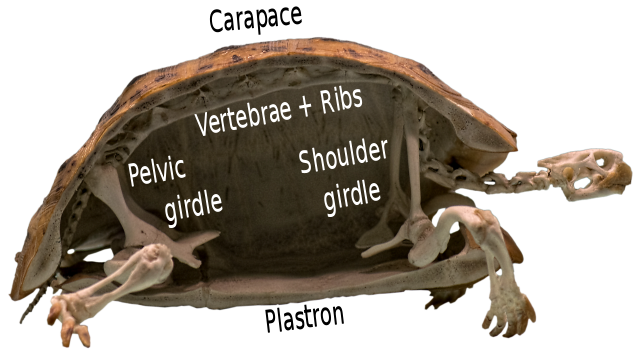



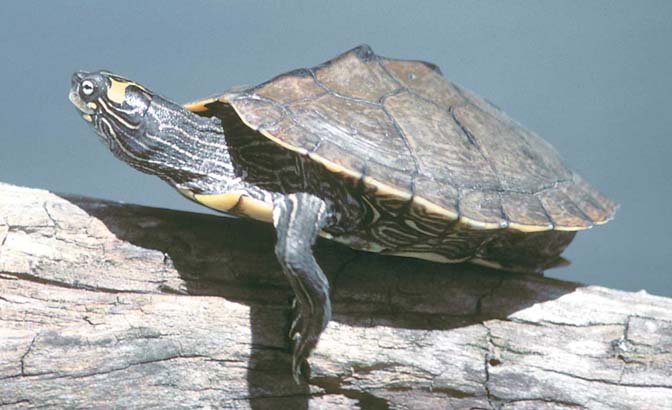



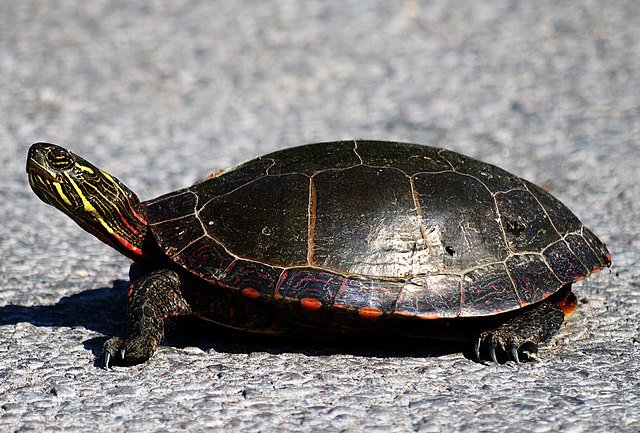

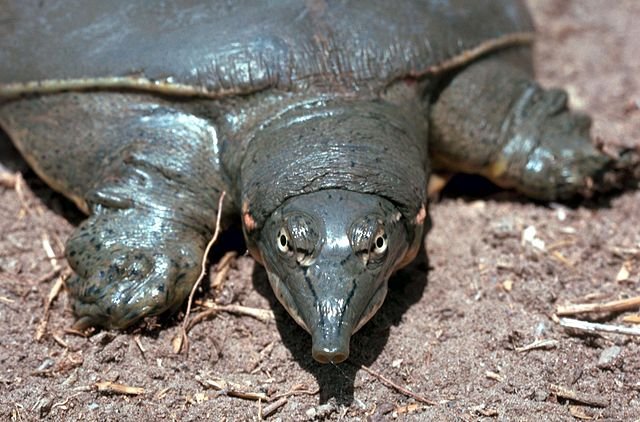




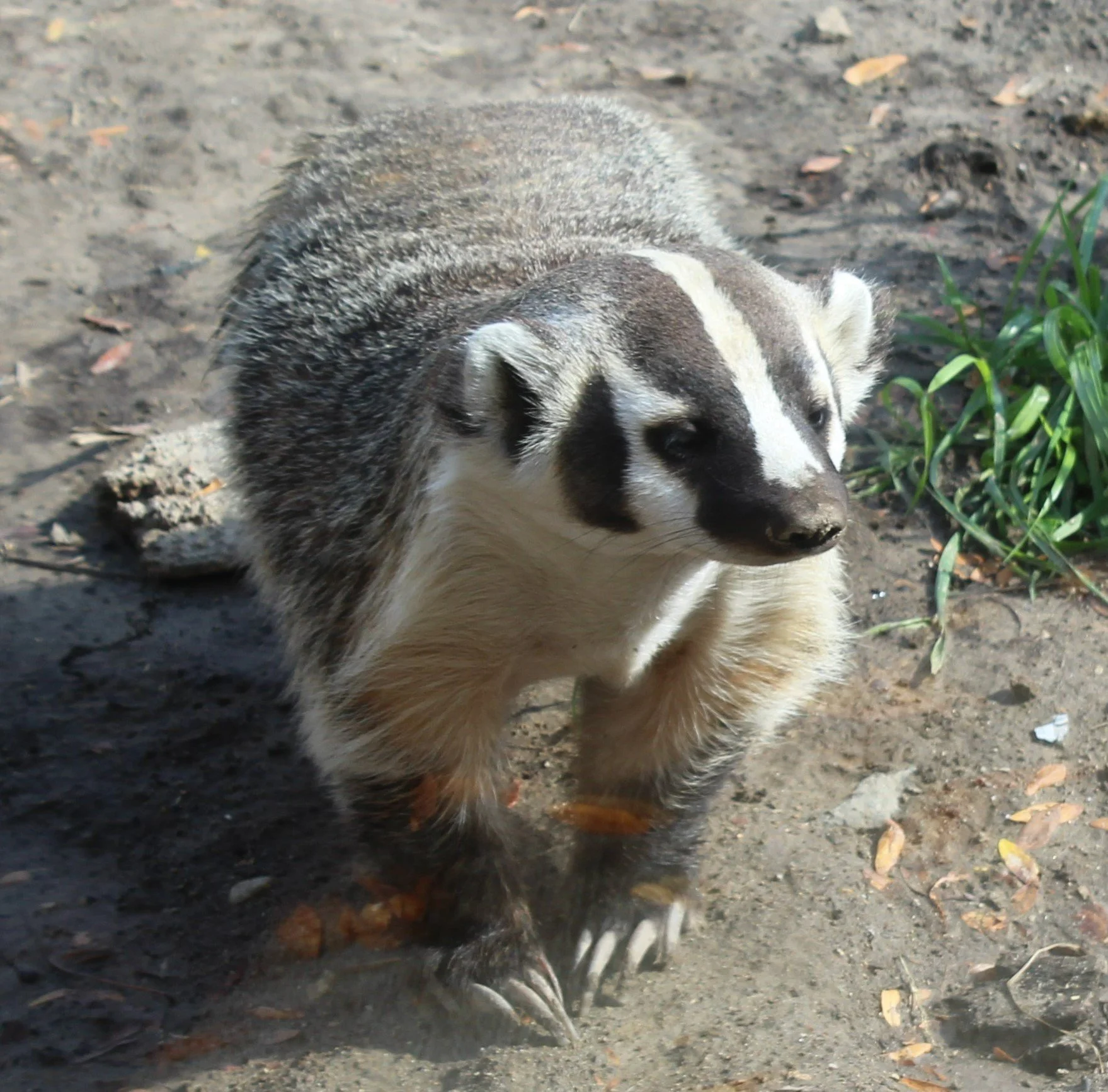



There are two species living in the United States, the common snapping turtle and the alligator snapping turtle. They live in freshwater habitats feeding on small animals.
Populations of the alligator snapping turtle are in decline and they are considered a vulnerable species. Habitat loss, climate change, and poaching are all reasons for this.